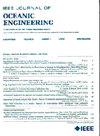CA-Net: Cascaded Adaptive Network for Underwater Image Enhancement
IF 5.3
2区 工程技术
Q1 ENGINEERING, CIVIL
引用次数: 0
Abstract
Due to light absorption and scattering, underwater images often suffer from low contrast, blurry details, and color deviation. Various enhancement methods have been developed, but many fail to improve image quality effectively and sometimes create unnatural effects. To tackle such a problem, we propose a novel method, namely the Cascaded Adaptive Network (i.e., CA-Net), to comprehensively enhance the quality of underwater images. Specifically, our network adopts a cascaded enhancement architecture consisting of three stages (coarse feature restoration, feature aggregation, and color refinement). First, we use a detail restoration (DR) module and channel balance module to recover spatial details and correct color distortion, respectively, in the first stage. Particularly, the detail guidance unit of DR employs encoder features to steer the decoder features to focus more on the spatial details of objects. Second, to promote the fusion of fine details and color features, we deploy a context attention (CA) module and an adaptive feature fusion (AFF) module in the stage of feature aggregation. CA extracts detailed restoration features and long-range dependencies in images, guiding the fusion process in the subsequent AFF. Lastly, to guarantee natural colors, we use a global color rendering module in the stage of color refinement, which adaptively groups and tunes the image channels. Experiments on public data sets show that CA-Net significantly outperforms existing methods, making it highly effective for underwater image enhancement.ca网:用于水下图像增强的级联自适应网络
由于光的吸收和散射,水下图像往往遭受低对比度,模糊的细节,和色彩偏差。人们开发了各种增强方法,但许多方法都不能有效地提高图像质量,有时还会产生不自然的效果。为了解决这一问题,我们提出了一种新的方法,即级联自适应网络(即CA-Net),以全面提高水下图像的质量。具体来说,我们的网络采用了由三个阶段(粗特征恢复、特征聚合和颜色细化)组成的级联增强架构。首先,我们在第一阶段分别使用细节恢复(DR)模块和通道平衡模块来恢复空间细节和纠正色彩失真。其中,DR的细节引导单元利用编码器特征引导解码器特征更加关注物体的空间细节。其次,为了促进精细细节和颜色特征的融合,我们在特征聚合阶段部署了上下文关注(CA)模块和自适应特征融合(AFF)模块。CA提取图像中的详细恢复特征和远程依赖关系,指导后续AFF的融合过程。最后,在颜色细化阶段,我们使用全局显色模块,自适应地对图像通道进行分组和调整,以保证图像的自然色彩。在公开数据集上的实验表明,CA-Net显著优于现有方法,对水下图像增强非常有效。
本文章由计算机程序翻译,如有差异,请以英文原文为准。
求助全文
约1分钟内获得全文
求助全文
来源期刊

IEEE Journal of Oceanic Engineering
工程技术-工程:大洋
CiteScore
9.60
自引率
12.20%
发文量
86
审稿时长
12 months
期刊介绍:
The IEEE Journal of Oceanic Engineering (ISSN 0364-9059) is the online-only quarterly publication of the IEEE Oceanic Engineering Society (IEEE OES). The scope of the Journal is the field of interest of the IEEE OES, which encompasses all aspects of science, engineering, and technology that address research, development, and operations pertaining to all bodies of water. This includes the creation of new capabilities and technologies from concept design through prototypes, testing, and operational systems to sense, explore, understand, develop, use, and responsibly manage natural resources.
 求助内容:
求助内容: 应助结果提醒方式:
应助结果提醒方式:


